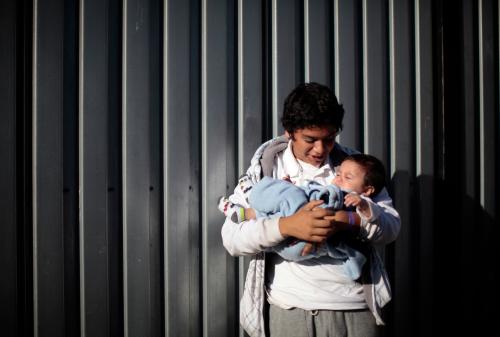Editor’s Note: In a Washington Post article, William Frey examines the cultural gap between white baby boomers and the growing minority youth population. Frey argues that although a cultural gap exists, it is this diverse youth population that the baby boomers will rely upon in retirement to keep paying into Social Security and Medicare.
Long associated in the popular mind with social and political change, the baby boomers are about to confront the biggest change in the American fabric in their lifetimes: our country’s new demographics. And they’re not ready.
Recent census numbers show that white babies are, for the first time, a minority of all births, putting an exclamation point on a trend that has been building for decades. A glance around schoolyards and community centers shows that children are becoming more racially and ethnically diverse than ever.
It is this diverse youth population that the largely white baby boomers will rely upon in their retirement years to keep paying into Social Security and Medicare.
Yet a Pew Research Center survey published in November showed only 23 percent of baby boomers regard the country’s growing population of immigrants as a change for the better. Forty-three percent saw it as a change for the worse. Almost half of white boomers said the growing number of newcomers from other countries represented a threat to traditional U.S. customs and values.
Older whites in general tend to be less favorable to more government programs, except Social Security, a significant change from their views in the late 1980s. Nowadays, younger minorities hold the views that boomers used to have, supporting government programs they see as important for their upward mobility
What’s emerging is a cultural gap between the largest generation and the youngest.
That divide is created by the size and cultural dominance of the 78-million-member baby-boom generation. A generation that once expressed distrust for anyone older than 30 is now itself isolated from a younger, far more diverse America.
Boomers were born to parents whose upward mobility was aided by sweeping public programs such as the GI Bill. They benefitted from a wide array of programs supporting higher education and became a highly educated generation. Still, this generation — which will swell the ranks of senior citizens in the coming years — seems to be having trouble letting go, showing more than a little antipathy toward today’s diverse, younger Americans.
Why is this happening? Part of the reason is that boomers grew up in an era when immigration was at its nadir. From 1946 to 1964, the share of immigrants was at the lowest level in the 20th century, and most of the immigrants were white Europeans. So boomers had minimal involvement with people other countries. Today, immigrants are 13 percent of our population, and they are far more diverse.
That created an isolation that persists. Among Americans older than 50, 76 percent are white, and the black population, at 10 percent, is the largest minority. Among those younger than 30, 55 percent are whites. Hispanics, Asians and other nonblack minorities account for 31 percent of that age group. Younger people are much more likely to be first- and second-generation Americans of non-European ancestry and able to speak English and other languages.
Yet, no matter the disconnect, the youngest and the oldest generations are inextricably linked.
The 2010 Census told us we would have faced an absolute decade-long decline in our under-18 population, had it not been for the gain of 5.5 million Hispanic and Asian youths. Between now and 2030, there will be an absolute decline of 10 million (mostly baby-boom) whites from the ranks of our working-age population.
Those ranks can be replenished only by the growing minority youth population. Much of this growth will occur because of births, regardless of immigration trends.
The contributions these people make will depend heavily on the opportunities they receive, particularly through education. Barriers are especially challenging for many minority children with talent and high aspirations, who continue to attend segregated, underfunded school systems. Currently, high school dropout rates for Hispanics are more than twice as high as those of non-Hispanic whites. More than a third of Hispanic and black children live in poverty.
Advancement of our young people into middle-class jobs at all skill levels is essential to future economic growth. That growth is, in turn, essential to our country’s ability to provide opportunities and social supports. Absent these investments, we are looking at a society whose members will be fighting over pieces of a shrinking pie.
Because of their numbers and clout, the voices of baby boomers will be heard. Let’s hope they, in turn, hear the message that their future, as well as the nation’s, is tied to the well-being of today’s diverse, striving younger Americans.


Commentary
Op-edBaby Boomers Had Better Embrace Change
June 8, 2012